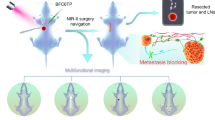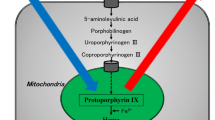Abstract
Purpose
Probe-based confocal laser endomicroscopy (pCLE) is a novel technique allowing real-time and high-resolution imaging in vivo. It provides microscopic images and increases the penetration depth of tissues compared with conventional white light endoscopy. The aim of the present study was to track ovarian cancer cells in organs by fluorescent polymer dots based on pCLE.
Procedures
SKOV3-mCherry cells were incubated with polymer dots for 24 h in a serum-free culture medium. Labeled cells were administrated to nude mice via intravenous, intraperitoneal, and lymph node injection. The fluorescent signals of labeled cells in organs were observed by pCLE. Furthermore, the results were confirmed by frozen section analysis.
Results
pCLE displayed fluorescence signals of labeled cells in the vessels of organs. Besides, the accumulations of labeled cells visualized in detoxification organs like the spleen and kidney were increased with time.
Conclusions
In this article, we present a real-time and convenient method for tracking SKOV3-mCherry in living mice by combined fluorescent polymer dots with pCLE.




Similar content being viewed by others
References
Chen D, Wu I, Liu Z, Tang Y, Chen H, Yu J, Wu C, Chiu DT (2017) Semiconducting polymer dots with bright narrow-band emission at 800 nm for biological applications. Chem Sci 8:3390–3398
Jeong S, Jung Y, Bok S, Ryu YM, Lee S, Kim YE, Song J, Kim M, Kim SY, Ahn GO, Kim S (2018) Multiplexed in vivo imaging using size-controlled quantum dots in the second near-infrared window. Adv Healthc Mater. https://doi.org/10.1002/adhm.201800695
Geng J, Li K, Ding D, Zhang X, Qin W, Liu J, Tang BZ, Liu B (2012) Lipid-PEG-folate encapsulated nanoparticles with aggregation induced emission characteristics: cellular uptake mechanism and two-photon fluorescence imaging. Small 8:3655–3663
**ong L, Guo Y, Zhang Y, Cao F (2016) Highly luminescent and photostable near-infrared fluorescent polymer dots for long-term tumor cell tracking in vivo. J Mater Chem B 4:202–206
Li J, Rao J, Pu K (2018) Recent progress on semiconducting polymer nanoparticles for molecular imaging and cancer phototherapy. Biomaterials 155:217–235
Zhen X, **e C, Pu K (2018) Temperature-correlated afterglow of a semiconducting polymer nanococktail for imaging-guided photothermal therapy. Angew Chem 130:4002–4006
Guo L, Ge J, Wang P (2018) Polymer dots as effective phototheranostic agents. Photochem Photobiol 94:916–934
Miao Q, **e C, Zhen X, Lyu Y, Duan H, Liu X, Jokerst JV, Pu K (2017) Molecular afterglow imaging with bright, biodegradable polymer nanoparticles. Nat Biotechnol 35:1102–1110
Kim J, Lee TS (2018) Emission tuning with size-controllable polymer dots from a single conjugated polymer. Small 1702758:1–7
Jiang Y, Pu K (2018) Molecular fluorescence and photoacoustic imaging in the second near-infrared optical window using organic contrast agents. Adv Biosys 1700262:1–10
Guo Y, Li Y, Yang Y, Tang S, Zhang Y, **ong L (2018) Multiscale imaging of brown adipose tissue in living mice/rats with fluorescent polymer dots. ACS Appl Mater Inter 10:20884–20896
Zhu H, Fang Y, Zhen X, Wei N, Gao Y, Luo KQ, Xu C, Duan H, Ding D, Chen P, Pu K (2016) Multilayered semiconducting polymer nanoparticles with enhanced NIR fluorescence for molecular imaging in cells, zebrafish and mice. Chem Sci 7:5118–5125
Jiang Y, Pu K (2018) Multimodal biophotonics of semiconducting polymer nanoparticles. Accounts Chem Res 51:1840–1849
Ganta S, Singh A, Kulkarni P, Keeler AW, Piroyan A, Sawant RR, Patel NR, Davis B, Ferris C, O'Neal S, Zamboni W, Amiji MM, Coleman TP (2015) EGFR targeted theranostic nanoemulsion for image-guided ovarian cancer therapy. Pharm Res 32:2753–2763
Yang Q, Yang Y, Zhou N, Tang K, Lau WB, Lau B, Wang W, Xu L, Yang Z, Huang S, Wang X, Yi T, Zhao X, Wei Y, Wang H, Zhao L, Zhou S (2018) Epigenetics in ovarian cancer: premise, properties, and perspectives. Mol Cancer 17:109
Li L, Bi X, Sun H, Liu S, Yu M, Zhang Y, Weng S, Yang L, Bao Y, Wu J, Xu Y, Shen K (2018) Characterization of ovarian cancer cells and tissues by Fourier transform infrared spectroscopy. J Ovarian Res 11:64
Viswanathan S, Rani C, Delerue-Matos C (2012) Ultrasensitive detection of ovarian cancer marker using immunoliposomes and gold nanoelectrodes. Anal Chim Acta 726:79–84
Giri S, Shah SH, Batra K, Anu-Bajracharya, Jain V, Shukla H, Sekhon R, Rawal S (2016) Presentation and management of inguinal lymphadenopathy in ovarian cancer. Indian J Surg Oncol 7:436–440
Zhang B, Chen F, Xu Q et al (2017) Revisiting ovarian cancer microenvironment: a friend or a foe? Protein Cell 9:674–692
Pu T, **ong L, Liu Q, Zhang M, Cai Q, Liu H, Sood AK, Li G, Kang Y, Xu C (2017) Delineation of retroperitoneal metastatic lymph nodes in ovarian cancer with near-infrared fluorescence imaging. Oncol Lett 14:2869–2877
Ke C, Fang C, Yan J et al (2017) Molecular engineering and design of semiconducting polymer dots with narrow-band, near-infrared emission for in vivo biological imaging. ACS Nano 11:3166–3177
Wang KK, Carr-Locke DL, Singh SK, Neumann H, Bertani H, Galmiche JP, Arsenescu RI, Caillol F, Chang KJ, Chaussade S, Coron E, Costamagna G, Dlugosz A, Ian Gan S, Giovannini M, Gress FG, Haluszka O, Ho KY, Kahaleh M, Konda VJ, Prat F, Shah RJ, Sharma P, Slivka A, Wolfsen HC, Zfass A (2015) Use of probe-based confocal laser endomicroscopy (pCLE) in gastrointestinal applications. A consensus report based on clinical evidence. United Eur Gastroenterol J 3:230–254
Chene G, Chauvy L, Buenerd A, Moret S, Nadaud B, Beaufils E, le Bail-Carval K, Chabert P, Mellier G, Lamblin G (2017) In vivo confocal laser endomicroscopy during laparoscopy for gynecological surgery: a promising tool. J Gynecol Obstet Hum Reprod 46:565–569
Bisschops R, Bergman J (2010) Probe-based confocal laser endomicroscopy: scientific toy or clinical tool? Endoscopy 42:487–489
Wallace MB, Fockens P (2009) Probe-based confocal laser endomicroscopy. Gastroenterology 136:1509–1513
Richardson C, Colavita P, Dunst C, Bagnato J, Billing P, Birkenhagen K, Buckley F, Buitrago W, Burnette J, Leggett P, McCollister H, Stewart K, Wang T, Zfass A, Severson P (2018) Real-time diagnosis of Barrett’s esophagus: a prospective, multicenter study comparing confocal laser endomicroscopy with conventional histology for the identification of intestinal metaplasia in new users. Surg Endosc. https://doi.org/10.1007/s00464-018-6420-9
Wu L, Yu H, Zhou R, Luo J, Zhao J, Li Y, Wang K, Wang Y, Li H (2018) Probe-based confocal laser endomicroscopy for diagnosis of nasopharyngeal carcinoma in vivo. Laryngoscope. https://doi.org/10.1002/lary.27450
**ong L (2016) Recent advances on near-infrared-emitting poly[2-methoxy-5-(2-ethylhexyloxy)-1,4-phenylenevinylene] polymer dots for in vivo imaging. Gen Chem 2:99–106
Cao F, Guo Y, Li Y et al (2018) Fast and accurate imaging of lymph node metastasis with multifunctional near-infrared polymer dots. Adv Funct Mater 1707174:1–18
Guo Y, Cao F, Li Y, ** doped and coupled doxorubicin for nucleus-targeted chemotherapy. J Mater Chem B 5:2921–2930
**ong L, Cao F, Cao X, Guo Y, Zhang Y, Cai X (2015) Long-term-stable near-infrared polymer dots with ultrasmall size and narrow-band emission for imaging tumor vasculature in vivo. Bioconjug Chem 26:817–821
Trottmann M, Stepp H, Sroka R, Heide M, Liedl B, Reese S, Becker AJ, Stief CG, Kölle S (2015) Probe-based confocal laser endomicroscopy (pCLE)–a new imaging technique for in situ localization of spermatozoa. J Biophotonics 8:415–421
Wu G, Wang Z, Bian X, du X, Wei C (2014) Folate-modified doxorubicin-loaded nanoparticles for tumor-targeted therapy. Pharm Biol 52:978–982
Ocak M, Gillman AG, Bresee J, Zhang L, Vlad AM, Müller C, Schibli R, Edwards WB, Anderson CJ, Gach HM (2015) Folate receptor-targeted multimodality imaging of ovarian cancer in a novel syngeneic mouse model. Mol Pharm 12:542–553
Cao F, **ong L (2016) Folic acid functionalized PFBT fluorescent polymer dots for tumor imaging. Chinese J Chem 34:570–575
Meining A, Shah RJ, Slivka A, Pleskow D, Chuttani R, Stevens PD, Becker V, Chen YK (2012) Classification of probe-based confocal laser endomicroscopy findings in pancreaticobiliary strictures. Endoscopy 44:251–257
Han S, Woo S, Suh CH, Lee JJ (2018) Performance of pre-treatment 18F-fluorodeoxyglucose positron emission tomography/computed tomography for detecting metastasis in ovarian cancer : a systematic review and meta-analysis. J Gynecol Oncol 29
Trottmann M, Stepp H, Sroka R, Heide M, Liedl B, Reese S, Becker AJ, Stief CG, Kölle S (2015) Probe-based confocal laser endomicroscopy (pCLE) - a new imaging technique for in situ localization of spermatozoa. J Biophotonics 8:415–421
Funding
This study was supported by grants from the National Key R&D Program of China (2016YFC1303100), the National Natural Science Foundation of China (81671738, 81301261, and 21374059), the Shanghai Pujiang Project (13PJ1405000), and the Medicine-Engineering Cross Project of Shanghai Jiao Tong University (YG2016MS73).
Author information
Authors and Affiliations
Corresponding author
Ethics declarations
Ethical Approval
All animal experiments were performed in accordance with the guidelines of the Institutional Animal Care and Use Committee at Shanghai Jiao Tong University (Shanghai, China).
Conflict of Interest
The authors declare that they have no conflict of interest.
Additional information
Publisher’s Note
Springer Nature remains neutral with regard to jurisdictional claims in published maps and institutional affiliations.
Rights and permissions
About this article
Cite this article
Zhang, Y., Li, Y., Guo, Y. et al. Fluorescent Polymer Dots for Tracking SKOV3 Cells in Living Mice with Probe-Based Confocal Laser Endomicroscopy. Mol Imaging Biol 21, 1026–1033 (2019). https://doi.org/10.1007/s11307-019-01343-4
Published:
Issue Date:
DOI: https://doi.org/10.1007/s11307-019-01343-4




